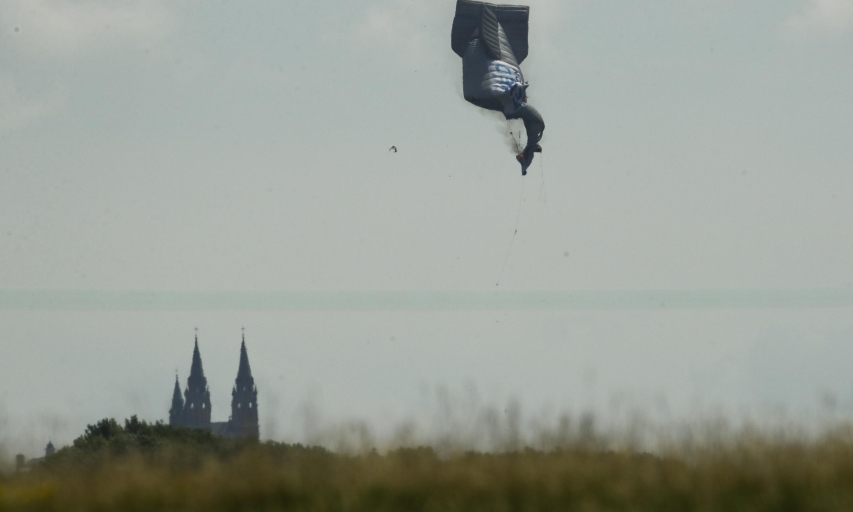Pilot Injured When Blimp Goes Down Near U.S. Open In Wisconsin
- Details
- Category: Inside Golf
- Published: 2017-06-16

A Blimp Crashes During The First Round Of The U.S. Open. An Official With The Company Operating The Advertising Blimp Said The Pilot Is “OK” After The Craft Crashed, But That He Was Taken To A Hospital. (AP Photo/Charlie Riedel)
ERIN, Wisconsin (AP) — A small blimp crashed near the U.S. Open on Thursday, seriously injuring the pilot and grabbing the attention of fans and golfers alike as they watched the fiery, smoking craft fall from the sky into an open field.
Sheriff's officials said the pilot was the only one on board. He had some burns, but was in stable condition, according to Pamela S. Sullivan, a senior air safety investigator with the National Transportation Safety Board.
"I was teeing off and I looked up and saw it on fire, and I felt sick to my stomach," Jamie Lovemark said after his opening round in one of golf's four majors. "I had the shakes. I felt terrible for the people inside. I didn't know what was going on. It was a horrible sight."
Golfer Brandt Snedeker said he spotted something while on the course at Erin Hills, about 35 miles northwest of Milwaukee.
"My caddie made a comment on the ninth hole. He said the blimp is not looking good," Snedeker said. "I guess it was nose down. I saw a puff of black smoke. I didn't know it was the blimp. It's not good. Glad everybody is OK."
Sullivan said the pilot had been interviewed by detectives from the Washington County Sheriff's Office, but the NTSB had not talked to him yet. He had just taken off on his second flight of the day in a hybrid of a typical blimp and a balloon envelope when he decided it was too windy and planned to return to a private airstrip.
He encountered an updraft on his way down and vented some of the air from the envelope so he could drop back down.
"When he was doing that he heard a sound similar to some of the panels ripping on the balloon," Sullivan said. "A couple seconds later he said he heard another rip sound. The airship pitched nose down.
"He turned off the manifold, the fuel to the burners. However, the envelope started collapsing and the burners were still burning the residual fuel. The envelope caught fire."
Sullivan said it's her understanding the pilot was able to crawl away from the burning wreckage. He was wearing a protective suit and gloves.
"He did have some burns, but that, we're assuming, probably was a huge factor in protecting him," she said.
The blimp, operated by Florida-based AirSign, was being used for advertising as it floated above the tournament.
A deputy at a security post reported seeing the aircraft on fire or smoking and rapidly descending about 11:15 a.m., authorities said. Rescue crews used utility vehicles to reach the crash site, about a half mile from the golf course.
Aerial video from a television news helicopter showed pieces of the flattened blimp on the field along with charred metal and grass. A handful of fans at the U.S. Open also posted video on Twitter of the craft's descent.
Just got to the #USOpen and the blimp caught fire and crashed. People parachuted out. pic.twitter.com/1lDi3VkXCu
— madison seigworth (@msiggyy) June 15, 2017
"It was a horrific scene," Lovemark said. "I've never seen a plane crash, blimp crash, anything like that. So it was pretty awful. I thought they might stop play."
Justin Maynard, a sales manager for AirSign, said the company's operations team on the ground in Erin had no definitive information on the pilot's condition, other than the pilot was expected to be OK.
Mary Ruediger, 45, was visiting her parents who live along an access road to the golf course and spotted the blimp going down.
"It was kind of floating and was deflating and I could see flames. Then it went behind the trees," Ruediger said. She said she drove toward the site where the blimp hit the ground.
"You could see the black smoke and then there were three big fireballs as it exploded," she said.
Associated Press photographer Charlie Riedel and AP writers Gretchen Ehlke, Doug Glass and Genaro C. Armas contributed to this report.



